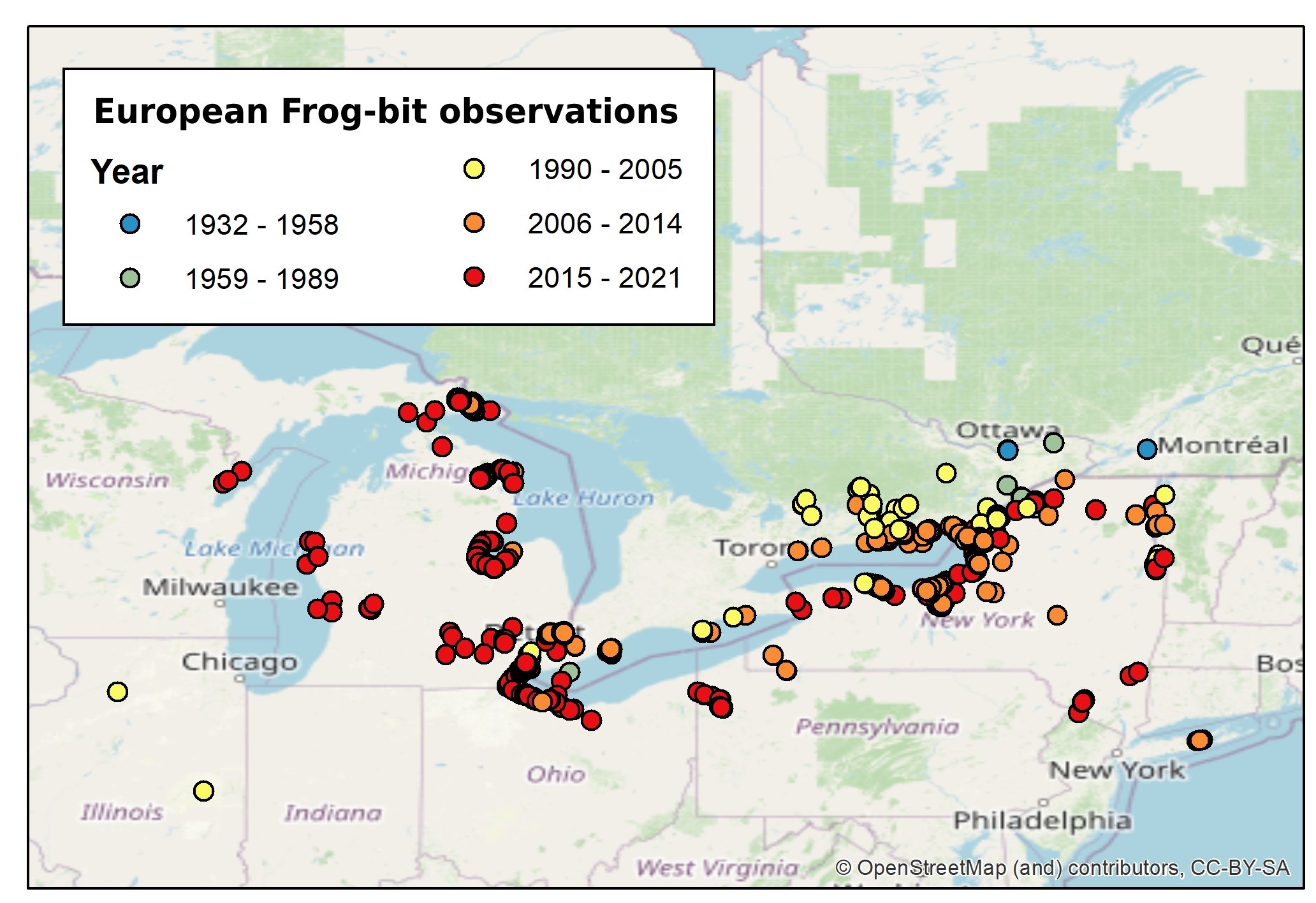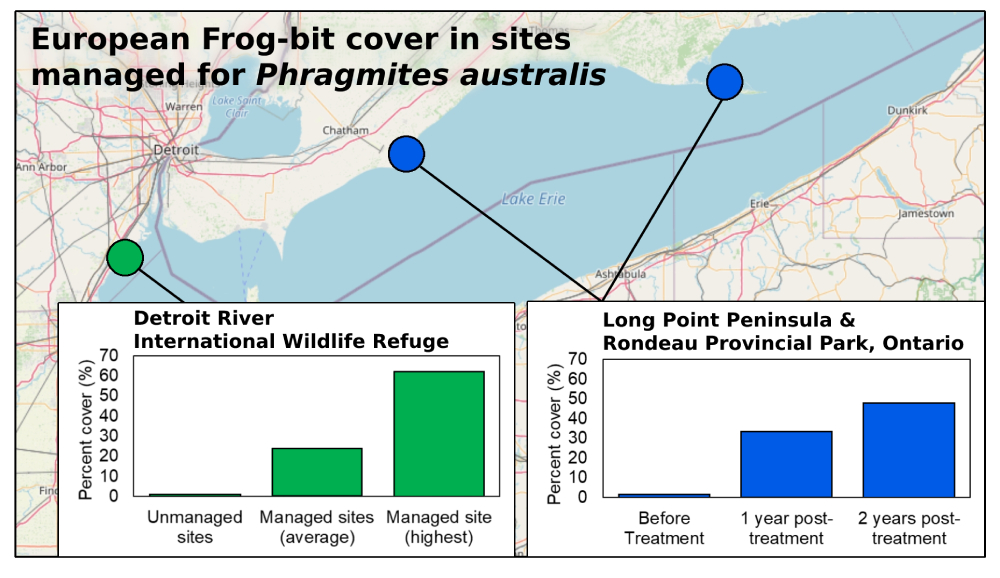April 29, 2022 – Taaja Tucker, U.S. Geological Survey

European frog-bit amid managed Phragmites stands at Lake Erie Metropark, Brownstown Charter Township, Michigan. Photo credit: Jake Bonello, U.S. Fish and Wildlife Service
What is frog-bit?
Invasive European frog-bit (EFB; Hydrocharis morsus-ranae) is a perennial aquatic plant that was introduced to Canada from Eurasia in the early 1900s and made its way to the United States in the 1970s.1 Despite its long presence in North America, many new observations of EFB have appeared around the Great Lakes in the last few years, primarily in coastal wetlands of Michigan, Ohio, Wisconsin, and New York2 (Figure 1). EFB grows in slow-moving water, often co-occurring with emergent plants like cattails and Phragmites.3 The plant grows quickly, forming dense floating mats that can block light for submerged aquatic vegetation and deplete oxygen levels, block off areas intended for navigation or recreational activities (such as kayaking), and can slow water flow.1 It uses seeds, turions (dormant vegetative buds), and stolons (runners) to reproduce, all of which can be spread to new areas if attached to boats, equipment, and wildlife. Current management techniques include 1) prevention of spread (e.g., boat washing stations, educational signs), 2) physical removal (e.g., manual removal, large equipment), 3) aquatic herbicides (e.g., diquat, endothall, flumioxazin), or 4) drawing down water levels.4 Management for EFB is most effective when performed before late summer or fall when the plant produces its spreadable seeds and turions. Managers and researchers across the Great Lakes are working together to determine the best ways to track and manage this new invasive as part of the European Frog-bit Collaborative (website forthcoming).

Figure 1. Great Lakes observations of European frog-bit submitted to the USGS Nonindigenous Aquatic Species database2 by year (current as of April 15, 2022).
Frog-bit and Phragmites
A common occurrence in the management of invasive plants is “secondary invasion,” the growth of one or more different invasive/non-native plant species after the target species has been reduced or removed. There are many potential causes for secondary invasion, including nontarget effects of herbicides on native plants, anthropogenic disturbances, alteration of site conditions by the primary invasive, or shifting environmental conditions.5 There is some evidence to suggest secondary invasion of EFB may occur in wetlands where Phragmites is managed. Here we consider two case studies from coastal wetlands of Lake Erie: work performed by Bonello and Judd within the Detroit River International Wildlife Refuge (DRIWR), Michigan in 20186 and by Robichaud and Rooney at Long Point Peninsula and Rondeau Provincial Park, Ontario during 2016-2018.7 EFB tends to grow around emergent vegetation because it provides refuge from wind and waves3 and was thus already present in low amounts in both studies (<2% cover). However, in sites where herbicide management of Phragmites occurred, cover of EFB increased dramatically, averaging 34% cover one year after Phragmites management and 48% cover two years after management in Ontario (Figure 2)7. In DRIWR, average cover was 24% at managed sites, with one site as high as 62% cover (Figure 2)6.

Figure 2. Percent cover of European frog-bit (EFB) at sites managed for Phragmites australis. The first plot (left) shows differences in EFB percent cover between unmanaged sites, the average of all managed sites, and the highest value observed at a single site at the Detroit River International Wildlife Refuge (data from Bonello and Judd, 20206). The second plot (right) shows the difference in average EFB percent cover at sites in Long Point Peninsula and Rondeau Provincial Park before Phragmites treatment, 1 year post-treatment, and 2 years post-treatment (data from Robichaud and Rooney, 20217).
Although one study took a before-and-after approach, and the other looked at percent coverage between managed and unmanaged sites, both observed increases in EFB associated with Phragmites herbicide management. Robichaud and Rooney suggested that EFB expansion occurred not only because of Phragmites treatment, but also due to high water levels during the study years, which may have provided more habitat for EFB to invade.7 Removal of dead Phragmites stems may reduce the likelihood of EFB spread: in a similar study involving management of Typha cattails, standing dead stems were a predictor of EFB, but removal of stems reduced EFB due to the lack of shelter.3
PAMF… now with frog-bit!
Proliferation of invasive emergent plants like Phragmites and Typha may be aiding the spread of EFB throughout Great Lakes coastal wetlands.3 Because of the high likelihood of co-occurrence with Phragmites and/or secondary invasion of EFB after Phragmites is managed, Phragmites managers are in a unique position to provide timely information about new invasions. Observations of EFB have been made across much of the Great Lakes but more data are needed to track the spread of this species. The Phragmites Adaptive Management Framework (PAMF) is collaborating with the European Frog-bit Collaborative to aid in tracking the spread of invasion by providing presence/absence and qualitative density estimates of EFB at PAMF management units. This monitoring consists of only two optional questions on the monitoring sheet:
- Is European frog-bit present / absent within or adjacent to the management unit?
- If present, is it: sparse, patchy, dense, or monoculture?
PAMF encourages submitting EFB-related notes and photos with the standard PAMF monitoring form.
Not participating in PAMF and finding frog-bit? Submit an observation to the Midwest Invasive Species Information Network (MISIN)!
Identification of frog-bit
Luckily, EFB is easy to identify! It looks similar to a lily pad, but the floating heart-shaped leaves are only 1.2–6 cm across. When in bloom from June to September, it has small white flowers with three petals and a yellow center (Figure 3A). Tangled roots hang below the plant in the water and can be up to 50 cm long. The growth form is dense, with many plants bunched together forming mats of vegetation (Figure 3B). Turions (Figure 3C) are 6-7 mm long. There are few plants EFB can be confused with; water lilies (Nymphaea and Nuphar spp.) have much bigger leaves and the water-shield (Brasenia schreberi) has maroon flowers and oval-shaped leaves. While similar in appearance, American frog-bit (Limnobium spongia) is native to the southern and eastern U.S. and is rarely found in the Great Lakes basin.4 Check out EGLE’s Guide to Common Aquatic Plants of Michigan for a quick guide to other aquatic plants one might encounter in the Great Lakes.

Figure 3. A. European frog-bit leaves and flowers. B. Mat-forming growth habit of European frog-bit. C. European frog-bit turion (dormant vegetative bud). All photos by Christian Fischer, CC BY-SA 3.0, via Wikimedia Commons.
More information
- See where in the Great Lakes basin EFB has been found: USGS NAS | EDDMapS
- Report EFB: Midwest Invasive Species Information Network (MISIN)
- State of Michigan’s European Frog-bit profile
References
- Nault, M.E., A. Mikulyuk. 2009. European frog-bit (Hydrocharis morsus-ranae): A technical review of distribution, ecology, impacts, and management. Wisconsin Department of Natural Resources Bureau of Science Services, Madison, Wisconsin, USA. PUB-SS-1048 2009. 🔗
- U.S. Geological Survey. 2022. Nonindigenous Aquatic Species Database. USGS, Gainesville, Florida. Accessed 4/15/2022. 🔗
- Monks, A.M., S.C. Lishawa, K.C. Wellons, D.A. Albert, B. Mudrzynski, D.A. Wilcox. 2019. European frogbit (Hydrocharis morsus-ranae) invasion facilitated by non-native cattails (Typha) in the Laurentian Great Lakes. Journal of Great Lakes Research 45(5):912–920. 🔗
- Cahill, B.C., R. Hackett, A. Monfils. 2021. Status and strategy for European frog-bit (Hydrocharis morsus-ranae l.) management. Michigan Department of Environment, Great Lakes, and Energy, Lansing, Michigan. 🔗
- Pearson, D.E., Y.K. Ortega, J.B. Runyon, J.L. Butler. 2016. Secondary invasion: The bane of weed management. Biological Conservation 197:8–17. 🔗
- Bonello, J.E., K.E. Judd. 2020. Plant community recovery after herbicide management to remove Phragmites australis in Great Lakes coastal wetlands. Restoration Ecology 28(1):215–221. 🔗
- Robichaud, C.D., R.C. Rooney. 2021. Effective suppression of established invasive Phragmites australis leads to secondary invasion in a coastal marsh. Invasive Plant Science and Management 14(1):9–19. 🔗
